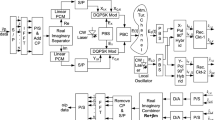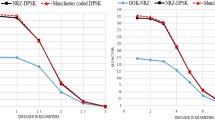Abstract
This paper details a novel model of Wavelength Division Multiplexed (WDM) system using Polarization Shift Keying (PolSK) modulation to increase the capacity of a Free-Space Optical System. The proposed system reduces the cross-channel effects and phase related variations of transmitting signal since PolSK transmits signals in two orthogonal polarized directions. A mathematical model for the system is developed and simulated. The closed-form expressions for the PolSK based WDM system is derived. A case study has been done to implement virtual class rooms in JJCET, Trichy to explore the benefit of using WDM using PolSK for different climatic conditions. The parameters like Bit Error Rate (BER) are analyzed for different weather conditions. The BER of 10−10 is obtained for a link distance of 15.3 km under gamma–gamma turbulence channel in heavy rain conditions, and 5.8 km link distance is achieved for fog conditions using this novel method. Four separate channels each with a data rate of 2.5 Gbps are multiplexed to increase the capacity of the system to 10 Gbps. The system is compared with WDM employing Amplitude Shift Keying under the same environmental conditions. The simulation results obtained for BER and received power against different atmospheric conditions are compared for both the modulation schemes and proved that PolSK based WDM offers better performance.
















Similar content being viewed by others
References
Ghassemlooy, Z., Popoola, W., & Rajbhandari, S. (2013). Optical wireless communications: System and channel modelling with MATLAB. New York: CRC Press.
Khaligi, M. A., & Uysal, M. (2014). Survey on free space optical communication: A communication theory perspective. IEEE Communication, Surveys and Tutorials, 16(4), 2231–2258.
Prabu, K., et al. (2017). BER analysis of SS-WDM based FSO System for Vellore weather conditions. Optics Communications, 403, 73–80.
Mahdy, A., & Deogun, A. G. S. (2004). Wireless optical communications: A survey. In Proceedings of the IEEE wireless communications and networking conference (WCNC), Atlanta, GA (pp. 2399–2404).
Prabu, K., Kumar, D. S., & Srinivas, T. (2014). Performance analysis of FSO links under strong atmospheric turbulence conditions using various modulation schemes. Optik, 125(19), 5573–5581.
Andrews, L. C., & Phillips, R. L. (2005). Laser beam propagation through random media (Vol. 1). Bellingham, Washington: SPIE Press.
Prabu, K., & Kumar, D. S. (2014). Bit error rate analysis of free-space optical system with spatial diversity over strong atmospheric turbulence channel with pointing errors. Optical Engineering, 53(12), 126108.
Matsumoto, M. (2012). Next generation free-space optical system by system design optimization and performance enhancement. In Proceedings of progress in electromagnetics research symposium (pp. 501–506).
Patnaik, B., Sahu, B. K. (2012). Novel QPSK modulation for DWDM free space optical communication system. In Wireless advanced (pp. 170–175).
Aldouri, M. Y., Mahdi, M., & Jameel, L. W. (2016). FSO optical system utilizing DPSK advance modulation technique. IJCSMC, 5, 149–160.
Popoola, W. O., Ghassemlooy, W., & Leitgeb, E. (2016). Free-space optical communication in atmospheric turbulence using DPSK subcarrier modulation. Research Gate, 27, 228818724.
Kiasaleh, K. (2005). Performance of APD-based, PPM free space optical communication systems in atmospheric turbulence. IEEE Transactions on Communications, 53, 1455–1461.
Khalighi, M. A., & Uysal, M. (2014). Survey on free space optical communication: A communication theory perspective. IEEE Communications Surveys & Tutorials, 16(4), 2231–2258.
Wang, Z. (2009). Performance comparison of different modulation formats over free-space optical (FSO) turbulence links with space diversity reception technique. IEEE Photonics Journal, 1, 277–285.
Uysal, M., Navidpour, S. M., & Li, J. (2004). Error rate performance of coded free-space optical links over strong turbulence channels. IEEE Communications Letters, 8, 635–637.
Parkash, S., Kumar, D., Sharma, A., Malhotra, R. (2014). Performance investigation of GE-PON fiber to the home network under varying data rates and users. In Proceedings of the international multi-track conference (IMTC’14) (Vol. 1, pp. 156–159), Jalandhar, India.
Sharma, V., Lumba, M., & Kaur, G. (2014). Severe climate sway in coherent CDMA-OSSB-FSO transmission system. Optik - International Journal for Light and Electron Optics, 125(19), 5705–5707.
Zhao, L., Chi, X., Li, P., & Guan, L. (2015). A MPR optimization algorithm for FSO communication system with star topology. Optics Communications, 356, 147–154.
Sharma, A., Kumar, M., Ashima, B., & Parkash, S. (2015). Dynamics of chirped RZ modulation format in GEPON fiber to the home (FTTH) network. International Journal of Electrical and Computer Engineering, 2(7), 456–460.
Jurado-Navas, A., Garcia-Zambrana, A., & Puerta-Notario, A. (2007). Efficient lognormal channel model for turbulent FSO communications. Electronics Letters, 43, 178–179.
Andrews, L. C., Phillips, R. L., & Hopen, C. Y. (2001). Laser beam scintillation with applications. Bellingham, WA: SPIE.
Habash, M., Andrews, L. C., & Phillips, R. L. (2001). Mathematical model for the irradiance probability density function of a laser beam propagating through turbulent media. Society. Photo-Optical. Instrumentation Engineering, 40, 1554–1562.
Aladeloba, A. O., Woolfson, M. S., & Phillips, A. J. (2013). WDM FSO network with turbulence-accentuated interchannel crosstalk. IEEE/OSA Journal of Optical Communications and Networking, 5(6), 641–651.
Bouchet, O., El Tabach, M., Wolf, M., O Brien, D. C., Faulkner, E., Walewski, J., et al. (2008) Hybrid wireless optics (HWO): Building the next-generation home network. In 6th international symposium on communication systems, networks and digital signal processing, CNSDSP, Graz, Austria (pp. 283–287).
Author information
Authors and Affiliations
Corresponding author
Additional information
Publisher's Note
Springer Nature remains neutral with regard to jurisdictional claims in published maps and institutional affiliations.
Rights and permissions
About this article
Cite this article
Jeyaseelan, J., Kumar, D.S. & Caroline, B.E. PolSK and ASK Modulation Techniques Based BER Analysis of WDM-FSO System for Under Turbulence Conditions. Wireless Pers Commun 103, 3221–3237 (2018). https://doi.org/10.1007/s11277-018-6004-y
Published:
Issue Date:
DOI: https://doi.org/10.1007/s11277-018-6004-y




